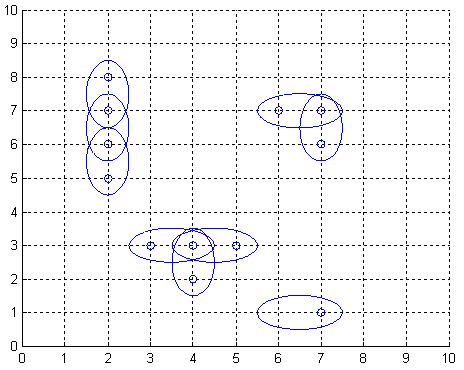POJ3020 Antenna Placement(二分图匹配 匈牙利算法)
来源:互联网 发布:米8运输直升机数据 编辑:程序博客网 时间:2024/06/09 03:13
Antenna Placement
Time Limit: 1000MS Memory Limit: 65536KTotal Submissions: 7044 Accepted: 3498
Description
The Global Aerial Research Centre has been allotted the task of building the fifth generation of mobile phone nets in Sweden. The most striking reason why they got the job, is their discovery of a new, highly noise resistant, antenna. It is called 4DAir, and comes in four types. Each type can only transmit and receive signals in a direction aligned with a (slightly skewed) latitudinal and longitudinal grid, because of the interacting electromagnetic field of the earth. The four types correspond to antennas operating in the directions north, west, south, and east, respectively. Below is an example picture of places of interest, depicted by twelve small rings, and nine 4DAir antennas depicted by ellipses covering them.

Obviously, it is desirable to use as few antennas as possible, but still provide coverage for each place of interest. We model the problem as follows: Let A be a rectangular matrix describing the surface of Sweden, where an entry of A either is a point of interest, which must be covered by at least one antenna, or empty space. Antennas can only be positioned at an entry in A. When an antenna is placed at row r and column c, this entry is considered covered, but also one of the neighbouring entries (c+1,r),(c,r+1),(c-1,r), or (c,r-1), is covered depending on the type chosen for this particular antenna. What is the least number of antennas for which there exists a placement in A such that all points of interest are covered?

Obviously, it is desirable to use as few antennas as possible, but still provide coverage for each place of interest. We model the problem as follows: Let A be a rectangular matrix describing the surface of Sweden, where an entry of A either is a point of interest, which must be covered by at least one antenna, or empty space. Antennas can only be positioned at an entry in A. When an antenna is placed at row r and column c, this entry is considered covered, but also one of the neighbouring entries (c+1,r),(c,r+1),(c-1,r), or (c,r-1), is covered depending on the type chosen for this particular antenna. What is the least number of antennas for which there exists a placement in A such that all points of interest are covered?
Input
On the first row of input is a single positive integer n, specifying the number of scenarios that follow. Each scenario begins with a row containing two positive integers h and w, with 1 <= h <= 40 and 0 < w <= 10. Thereafter is a matrix presented, describing the points of interest in Sweden in the form of h lines, each containing w characters from the set ['*','o']. A '*'-character symbolises a point of interest, whereas a 'o'-character represents open space.
Output
For each scenario, output the minimum number of antennas necessary to cover all '*'-entries in the scenario's matrix, on a row of its own.
Sample Input
27 9ooo**oooo**oo*ooo*o*oo**o**ooooooooo*******ooo*o*oo*oo*******oo10 1***o******
Sample Output
175
题目大意:
一个矩形中,有N个城市’*’,现在这n个城市都要覆盖无线,若放置一个基站,那么它至多可以覆盖相邻的两个城市。问至少放置多少个基站才能使得所有的城市都覆盖无线?
思路:
本题需要有转化的思维,我们可以把*和o离散化,把o用0表示,*用第几个点来表示,这样我们就得到了一个图,各个顶点就是数值,这样我们就可以开数组了,用邻接矩阵去存,可知构成的图是双向的,双向的图可以认为是无向图,所以例如顶点1和顶点2能连通,那么我们置map[1][2] = map[2][1] = true表示能通,然后我们需要知道二分图匹配的一个公式 : 最小路径覆盖 = |P| - 最大匹配数,这个公式适合有向图,无向图其实也很简单只要将最大匹配数/2即可,因为无向图我们多算了一倍的最大匹配数,最后我们可以得到本题的公式 无向图的最小路径覆盖 = |P| (顶点个数) - 最大匹配数 / 2。本题只要思路清楚,1A.
代码如下:
#include<iostream>#include<cstring>#include<cstdio>using namespace std;const int maxn = 1000;int result[maxn];int map[maxn][maxn]; //离散化成点bool con[maxn][maxn]; //i,j是否连通bool visit[maxn];int cnt;bool dfs(int a){ int i; for(i=1;i<=cnt;i++) { if(!visit[i] && con[a][i]) { visit[i] = true; if(result[i] == 0 || dfs(result[i])) { result[i] = a; return true; } } } return false;}int main(){ int T; int m,n; char str; int i,j; int ans; //freopen("111","r",stdin); cin>>T; while(T--) { int res; ans = 0; memset(con,false,sizeof(con)); memset(result,0,sizeof(result)); cin>>m>>n; cnt = 0; for(i=1;i<=m;i++) { for(j=1;j<=n;j++) { cin>>str; if(str == 'o') { map[i][j] = 0; } else if(str == '*') { map[i][j] = ++cnt; } } } /* 行中列相邻 */ for(i=1;i<=m;i++) { for(j=1;j<n;j++) { int pos1 = map[i][j]; int pos2 = map[i][j+1]; if(pos1 && pos2) { con[pos1][pos2] = true; //无向图连通 con[pos2][pos1] = true; } } } /* 列中行相邻 */ for(i=1;i<=n;i++) { for(j=1;j<m;j++) { int pos1 = map[j][i]; int pos2 = map[j+1][i]; if(pos1 && pos2) { con[pos1][pos2] = true; con[pos2][pos1] = true; } } } /*for(i=1;i<=m;i++) { for(j=1;j<=n;j++) { cout<<map[i][j]; } cout<<endl; }*/ for(i=1;i<=cnt;i++) { memset(visit,false,sizeof(visit)); if(dfs(i)) { ans++; } } res = cnt - ans / 2; cout<<res<<endl; } return 0;} 0 0
- POJ3020 Antenna Placement(二分图匹配 匈牙利算法)
- POJ3020-Antenna Placement 无向二分图 匈牙利算法 裸题
- POJ3020--Antenna Placement--二分图最大匹配
- POJ3020 Antenna Placement 二分匹配
- poj3020--Antenna Placement(二分匹配)
- POJ3020 Antenna Placement 二分匹配 || 一般图匹配
- POJ3020——Antenna Placement(二分图最大匹配)
- poj3020 Antenna Placement(二分图)
- poj3020 Antenna Placement 二分匹配 最小路径覆盖
- POJ3020《Antenna Placement》方法:无向图最小路径覆盖 匈牙利算法
- POJ3020 Antenna Placement 解题报告--匈牙利
- Antenna Placement--匈牙利算法
- POJ3020 Antenna Placement【二分图最小边覆盖】
- POJ3020 Antenna Placement(二分图最小路径覆盖)
- poj3020 二分图最大匹配(匈牙利算法)
- poj 3020 Antenna Placement 匈牙利二分匹配 最小覆盖数 !!!!
- [二分图匹配] hunnu 10689 Antenna Placement
- poj 3020 Antenna Placement 二分图匹配
- 终于找到一个类似wince 远程桌面控制android设备的软件——Androidscreencast
- 如何用html5实现在网页上显示本地摄像头
- python默认json库处理mysql中datetime,date类型不能序列化json的解决方案
- UCOS学习问题(第一步)
- make mrproper及mrproper的含义
- POJ3020 Antenna Placement(二分图匹配 匈牙利算法)
- JVM 线程堆栈分析过程详解
- 关于使用java自带ZipOutputStream压缩文件名为中文的乱码问题
- 开启MyEclipse自动提示功能
- 浅析 Linux 初始化 init 系统,第 3 部分: Systemd
- GWT cache.js 404错误问题(显示白板)
- Leetcode:Populating Next Right Pointers in Each Node
- 用 Java 实现断点续传 (HTTP)
- cocos2d-x 系统动画


